MSU Graphics & Media Lab Report #3 on stereo films quality assessment
Graphics & Media Lab CMC of Lomonosov Moscow State University has about 10 years’ experience in comprehensive analyzing of compressed video. In March 2013 Graphics & Media Lab (in cooperation with IITP RAS) has already released two reports on stereo films quality assessment since March 2013. In these reports we presented our evaluation results and overall quality comparison of 10 stereo films altogether.
After a very successful release of Avatar the interest to stereo 3D films endures now a bad slump. Some people even think that 3D is dying and has no future. This decline of 3D demand has a serious background: many movie goers experience headache and eyestrain while watching a stereo film.
The Lab decided to analyze the stereo films and to investigate the potential reasons of the irritating annoyance. The first two reports were focused on films captured with stereoscopic camera systems, and the main problems discovered during the film analysis were:
- excessive horizontal disparity
- vertical disparity
- color mismatch
- sharpness mismatch (Image #1)
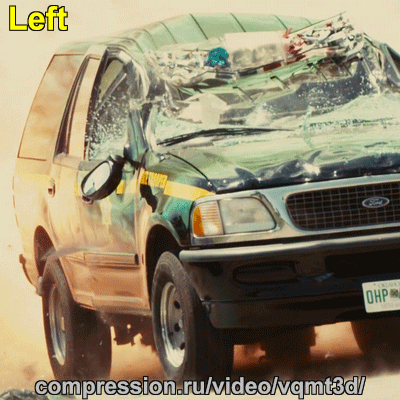
Image #1: Example of the sharpness mismatch
We’ve received a lot of positive comments from professional stereographers on these reports and were encouraged to continue the work on stereo film evaluation.
Andrew Enyart (Stereographer, VFX Supervisor)
In many cases flat scenes are simply victims of declining budgets. Often times, companies will prioritize shots on the basis of length or fast motion the idea being that if a shot is very short/fast, no one will notice that it is 2D. For the most part, this approach is acceptable to the viewing public because they simply don’t notice or don’t care. One of the problems of intercutting 2D and 3D is the cumulative result of the brain expecting something it doesn’t get. Over time, this mismatch in perception and expectation can result in a form of motion sickness (similar to when the ears and eyes don’t agree on what they are perceiving).
We are planning to publish three more reports in the 2nd half of 2013 and invite the stereographers for cooperation. Also, we are working hard to present our analysis of a stereo-window violation effect, which may be especially annoying in the more visible parts of the image. This issue appears in both captured and converted S3D films.
Now we would like to introduce our third report, in which we for the first time evaluate converted S3D films. The report includes the following converted S3D films:
- Alice in Wonderland
- Clash of the Titans
- Conan the Barbarian
- Green Lantern
- Abraham Lincoln: Vampire Hunter
2D-3D conversion introduces many new problems which are absent in captured S3D video. In our third report in addition to the problems, which were the focus of previous reports, we examine two common issues of converted S3D films:
- the cardboard effect (Image #2)
- edge sharpness mismatch (Image #3)
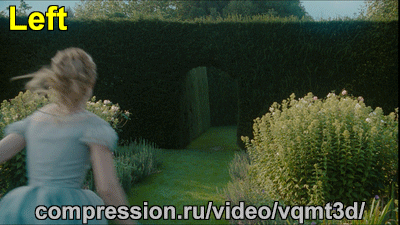
Image #2: Example of the cardboard effect: objects appear to be flattened in depth
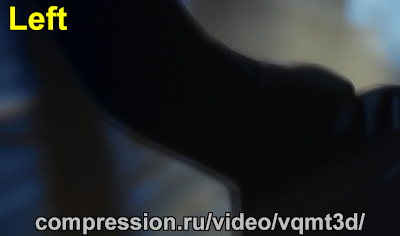
Image #3: Example of the edge sharpness mismatch
In the overall comparison of the examined films we compare 15 S3D movies altogether from all three reports.
Depth Budget
The report also provides the depth budget chart for both converted S3D films and captured ones (Image #4). It’s clear from this chart that ‘Green Lantern’ has no objects in front of the screen, while ‘Alice in Wonderland’ has.
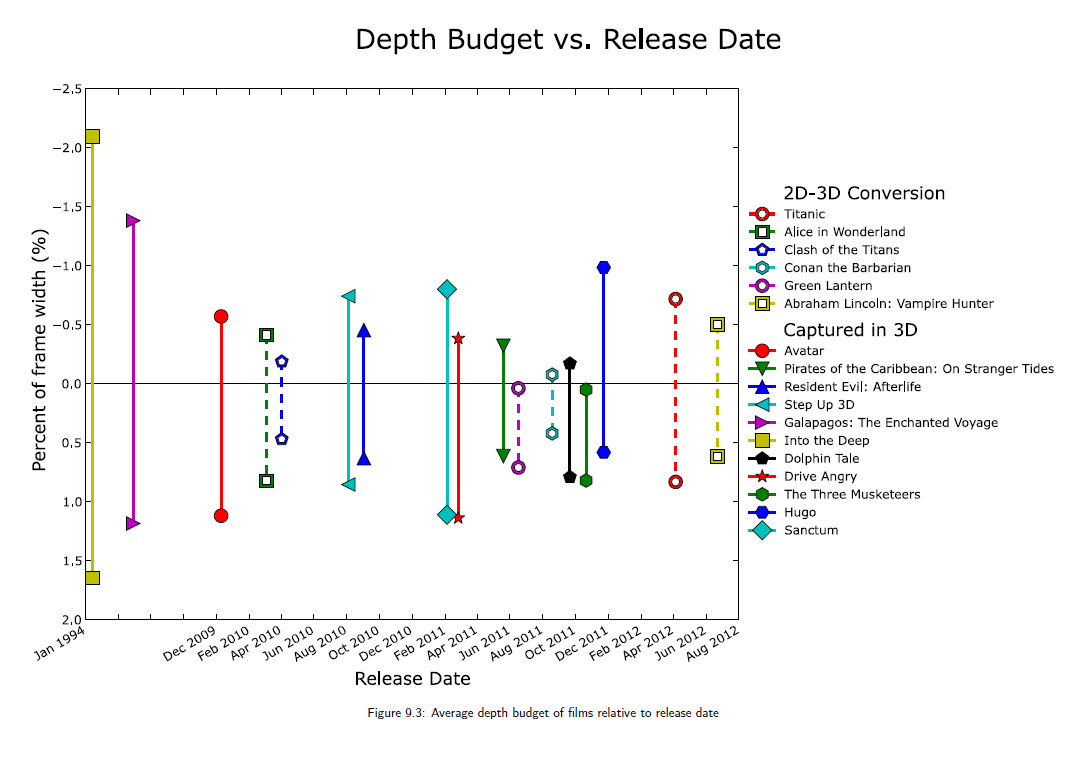
Image #4: Depth Budget vs. Release Date
Vertical Disparity
It’s also noticeable that converted S3D films generally have better vertical alignment than captured S3D films (Image #5). In fact, ‘Abraham Lincoln: Vampire Hunter’ has the best vertical alignment among the processed films.
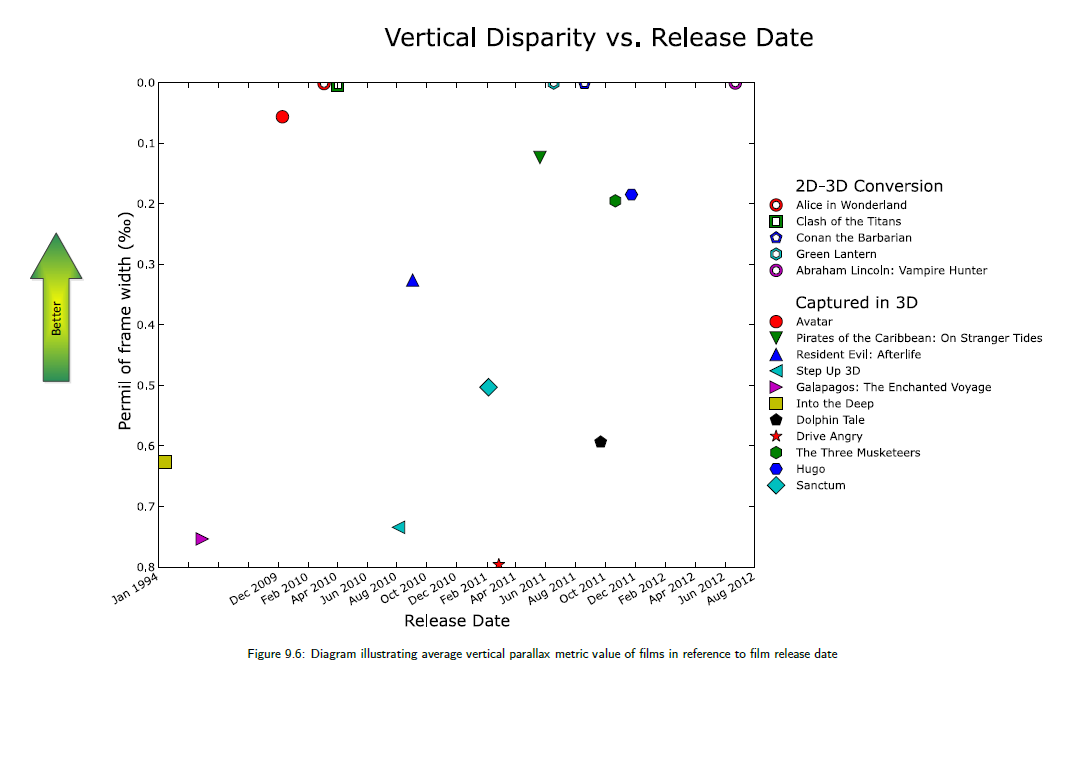
Image #5: Vertical Disparity vs. Release Date
Color mismatch
The same refers to color mismatch: the converted S3D films generally have much better color alignment between the left and right stereoscopic images (Image #6). However, color mismatch still appears in converted S3D films and it turned out that color mismatch in ‘Alice in Wonderland’ was stronger than in ‘Clash of the Titans’.
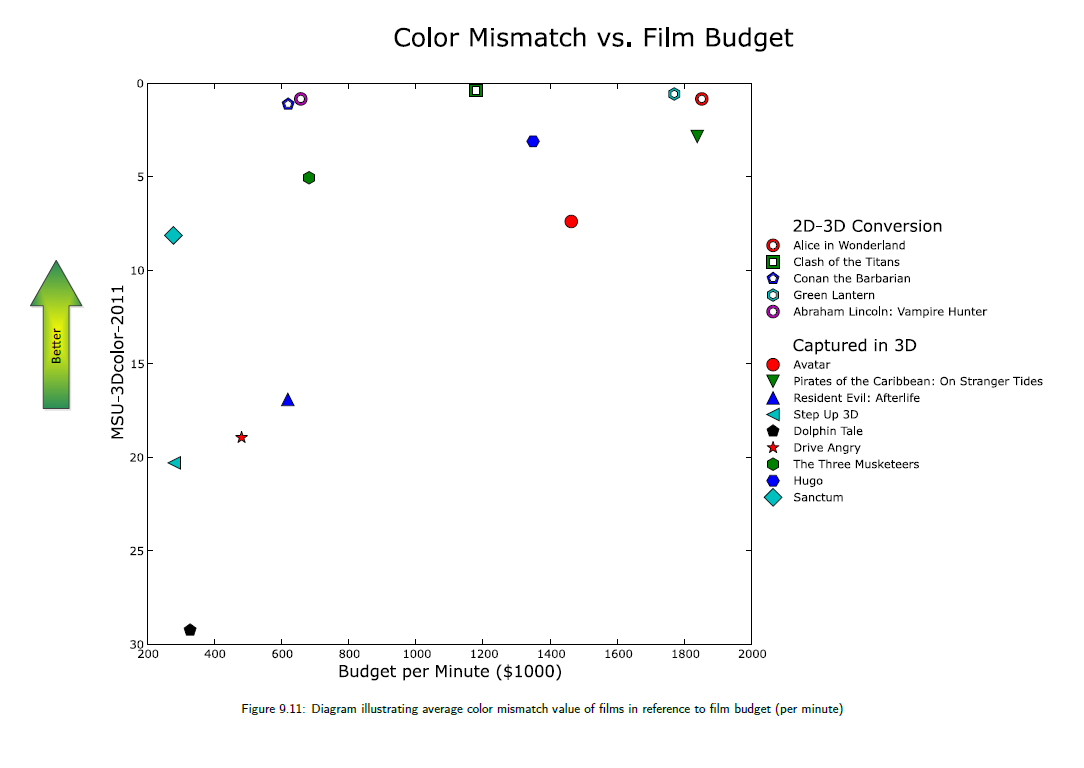
Image #6: Color Mismatch vs. Film Budget
Comparison of 2D & S3D versions
The report also contains a comparison of 2D & S3D versions of all five films. This research has several goals:
- Analysis and classification of different 2D-3D conversion techniques;
- Assessment of 2D-3D conversion quality from a slightly different perspective;
- Development of 2D-3D conversion quality-control tools.
Acknowledgements
We would like to thank the following people for providing valuable comments, opinions and feedback, which helped us to improve this report:
- Robert Black, 3D R&D, 3D Consultant / Stereographer
- Ross Copeland, Online Editor / Stereographer & Colourist, Post Production Consultant
- Andrew Enyart, Stereographer, VFX Supervisor
- Srboljub Hetlerovic, Stereographer, VFX Supervisor
- Jon Karafin, Senior Scientist and Director of Production Technology at RealD
- Greg Passmore, Director, PassmoreLab
- Daniele Pugni, 3D Motion Graphic Designer Freelancer for Sky 3D Channel-Sky Italia SRL
A key motive of this report is to improve the stereo quality and therefore to reduce eye- and headache. The Graphics & Media Lab hopes, that a high 3D video quality would contribute to a continually increasing number of people, leaving the modern theaters without annoyance and with good impressions from the image quality and storytelling. The report is available to all who may be concerned and interested in improving the quality of stereoscopic content. The next reports on 3D quality will be published in the near future on the website.
Reports overview
Stereo-analysis project description
Contacts
For questions and proposition please contact us 3dmovietest@graphics.cs.msu.ru
-
MSU Benchmark Collection
- Super-Resolution for Video Compression Benchmark
- Video Colorization Benchmark
- Defenses for Image Quality Metrics Benchmark
- Learning-Based Image Compression Benchmark
- Super-Resolution Quality Metrics Benchmark
- Video Saliency Prediction Benchmark
- Metrics Robustness Benchmark
- Video Upscalers Benchmark
- Video Deblurring Benchmark
- Video Frame Interpolation Benchmark
- HDR Video Reconstruction Benchmark
- No-Reference Video Quality Metrics Benchmark
- Full-Reference Video Quality Metrics Benchmark
- Video Alignment and Retrieval Benchmark
- Mobile Video Codecs Benchmark
- Video Super-Resolution Benchmark
- Shot Boundary Detection Benchmark
- The VideoMatting Project
- Video Completion
- Codecs Comparisons & Optimization
- VQMT
- MSU Datasets Collection
- Metrics Research
- Video Quality Measurement Tool 3D
- Video Filters
- Other Projects
